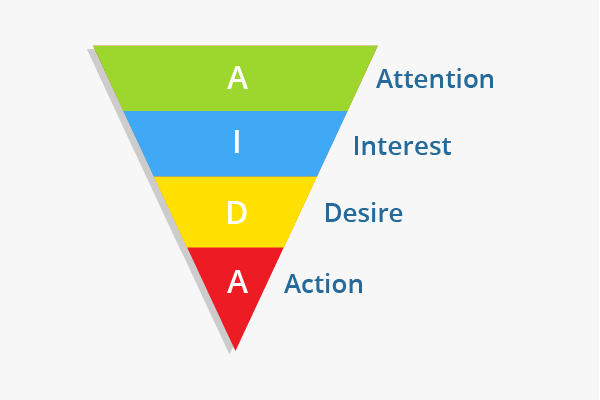
What does the AIDA model stand for?
The AIDA model is an acronym – it stands for attention, interest, desire and action. It is a model used in marketing that describes the steps a customer goes through in the process of purchasing a product. The AIDA model has been in use since the late 19th century. It has been reviewed and modified multiple times over the years, both in marketing and public relations.
Who created the AIDA model?
The AIDA model was developed by the American businessman, E. St. Elmo Lewis, in 1898. The original main purpose was to optimize sales calls, specifically the interaction between seller and buyer concerning the product.
Lewis can be considered a pioneer when it comes to the use of scientific methods for designing advertising and sales processes. At the same time, it was very important to Lewis to view advertising as a type of “training” that assisted the beneficiary. Lewis’s theoretical explanations of advertising theory rested on extensive experience. He was, for example, marketing head at various companies and advised organizations as well as companies involved in the conception of advertising measures and campaigns. He has shared his knowledge in the form of various publications — both in written form and in seminars at US universities. His AIDA model can be perceived as an important legacy, because the formula is still used more than 100 years after its first appearance, for example in digital marketing.
What is the AIDA approach?
The AIDA model is based on four individual stages that attract interested parties who are deciding on a product or service.
1. Attract attention: The product must attract the consumer’s attention. This is done via the advertising materials. It is a type of “eyecatcher.”
Examples: a window designed in a striking way, a sensational YouTube clip, or a themed newsletter, or a graphic on a landing page.
2. Maintain interest: In the first phase, the attention of the potential customer is piqued; their interest in the product or service should be aroused.
Example: detailed information on the product is presented, for example the product description on a website.
3. Create desire: If interest in the product is aroused, it is the seller’s task to persuade the customer that they want to own this product. In the best-case scenario, the advertisement or the product itself creates the desire to purchase.
4. Take action: As soon as the desire to buy is aroused, this must be transferred into an action, that is, the purchase.
In the case of online shops, this would ultimately be the shopping cart process, in which a customer is lead to a conversion.
Now, the AIDA formula is frequently supplemented with an “S” for “satisfaction”, because the product has to ultimately satisfy the consumer. Customer satisfaction does not lie solely with the advertising but rather with the product itself. Therefore, the basic constellation of the four phases is only the prerequisite for the sale.
With the insertion of the “confidence” (that is, trust) factor, a sixth element can also be added. Many marketers also work with the AIDCAS model to optimize sales processes and advertising.
How is AIDA used?
The AIDA model has shaped the views on marketing and sales strategies for over 100 years. The formula can still be found in current standard marketing textbooks. Beyond that, AIDA is also used in PR to plan and analyze the effectiveness of PR campaigns, and still provides valuable information for the analysis of advertising messages. The benefit of this simple formula can be found in its simplicity and flexible application possibilities in areas other than store-based or stationary sales. In e-commerce for example, the effectiveness of the product presentation in an online shop could be analyzed using the four aspects of the AIDA formula.
Criticism
For a long time, the AIDA model was viewed as exemplary for a successful sales process, but today there is general agreement that using this purely linear model alone is no longer suitable in modern sales processes. For example, the emotion that is often addressed in advertising and recognized by advertising psychology as elementary does not play a role in the AIDA formula. Targeting and, for example, considerations on socio-demographic background is also not included. AIDA also does not take into account the different points at which sales take place. The sales strategy for a customer visiting an online shop will be quite different to that for new a customer wanting to find out about a new car at the dealership.
The DAGMAR model appeared in 1961 as a descendant of the AIDA model. When advertisers today work with the AIDA model, they should always be aware of the fact that it is actually a phase model that cannot represent all individual aspects of the purchase process or advertising impact process. Nevertheless, Lewis’s work was important, as he was the first to present the sales process as a phase model, thus laying a groundwork for modern advertising.
REF: ryte
